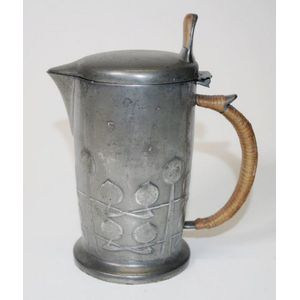
Archibald Knox Pewter Tea Set with Tray
A Liberty & Co, Tudric, pewter tea set and oval tray, designed by Archibald Knox, early 20th century, comprising a hand beaten teapot, hot water jug, sugar bowl and milk jug, plus a tray, stamped, Tudric, made in England, 6.69 in. high, the tray 14.17 in.…

Pewter Collection with Liberty and Co. Jug
A small collection of pewter including Liberty and Co., 19th century and later, the largest jug 7.09 in. high

Archibald Knox Pewter Jug and Bowl Set
Archibald Knox Liberty & Co Tudric pewter #0303 jug and bowl, diameter 4.33 in. bowl

Tudric Pewter Lidded Jug, Reg No. 421106, 15cm Height
Lidded jug pewter, marked Tudric 0278, Reg no 421106, height 5.91 in.

Tudric Archibald Knox Pewter Hot Water Jug
Tudric for Liberty of London pewter hot water jug Archibald Knox design, marked to base and # 0305 circa 1900, height 7.87 in.

Faulted Tudric Pewter Pieces from Brian Coote Estate
Three pieces of Liberty & Co. Tudric pewter, a jardiniere 0337, a vase 0327 and a jug 0195, all variously faulted. Provenance: The Estate of Emeritus Professor Brian Coote CBE, FRSNZ (1929 - 2019)

Embossed Tudric Pewter Lidded Jug with Cane Handle
Vintage Liberty Tudric pewter lidded jug, cane handle, embossed decoration, marked to base and # 0967, height 6.30 in.

Art Nouveau Pewter Hot Water Jug with Embossed Decoration
Tudric Pewter Art Nouveau hot water Jug embossed decoration,caned handle, height 8.66 in. approx.

Tudric Pewter Milk Jug for Liberty London, c. 1910
Archibald Knox Tudric pewter milk jug made for Liberty London, marked to base and # 0231 Reg No 420290, circa 1910, height 2.76 in.

Archibald Knox Tudric Pewter Lidded Jug with Honesty Decoration
An Archibald Knox Tudric pewter lidded jug, decorated with honesty, cane wrapping to handle and impressed marks to base. Height 5.12 in.

German Jugendstil Arts & Crafts Copper Jug
Jugendstil German Arts & Crafts krug, a copper and brass jug, 12.80 in. high

Tudric Pewter Jug with Enamel Cabochons and Cane Handle
A 'Tudric' pewter Archibald Knox design large jug, the hinged lid with flaring thumbpiece, the tapered body with traditional restrained design at the base with enamelled cabochons, some missing, woven cane handle, minor loss. Impressed marks including mode

Tudric Pewter Jug Vases with Elongated Handles and Collar
David Veasey for Liberty & Co., rare pair of Tudric pewter jug vases with elongated side handles and rope work collar, impressed mark 'Tudric 0213', approx 13.58 in. high (2)

Tudric Pewter and Green Glass Wine Jug
A Tudric pewter and green glass small wine jug, possibly an Archibald Knox design, the hinged lid with raised thumbpiece, the top and base mounts with raised heart motif and floral designs, the flared circular base marked beneath with impressed number 0330

Enamel and Cane Pewter Jug by Archibald Knox
Archibald Knox, English pewter lidded jug, with enamel decoration and woven cane handle